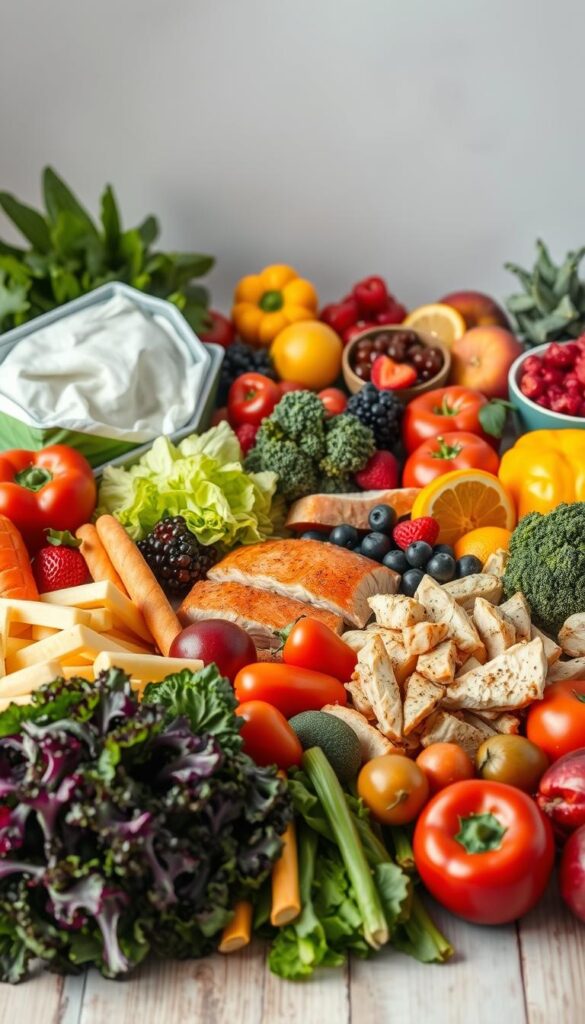
I’ve been there—counting calories, avoiding carbs, yet still feeling hungry and tired. The secret I found? Blood sugar balance is crucial for losing weight. When glucose levels are off, insulin stores fat, and cravings get worse. But, if you balance those numbers, your body starts burning fat instead.
Imagine eating meals that keep you full and having energy that lasts. Your metabolism will work for you, not against you. Blood sugar’s impact on weight loss is real: unstable levels can ruin even the best diets. My journey showed me that fixing this foundation leads to better results than traditional diets.
Key Takeaways
- Blood sugar balance prevents insulin spikes that store fat instead of burning it.
- High-fiber foods slow glucose absorption, avoiding crashes.
- Regular meals and exercise stabilize energy and glucose levels.
- Stress and sleep quality directly affect insulin sensitivity.
- Stabilizing blood sugar reverses insulin resistance linked to obesity and diabetes.
Understanding the Blood Sugar-Weight Connection
Many people struggle with blood sugar levels weight loss. When insulin levels are high, your metabolism slows down. This makes it hard to lose fat. Let’s explore why this happens.
How Blood Sugar Affects Your Metabolism
High glucose levels make your body store sugar as fat. When insulin stays high, your body burns sugar instead of fat. This makes it tough to lose weight. The January AI app shows how different foods affect you.
The Vicious Cycle of Blood Sugar Spikes and Crashes
Here’s how it works:
- Spikes: Sugary foods cause insulin spikes, halting fat burning
- Crashes: Low blood sugar triggers hunger, leading to overeating
- Repeat: The cycle repeats, making long-term weight loss tough
A 2016 study found that losing 5-10% of body weight improves health. But, without fixing insulin resistance, results don’t last.
Why Traditional Diets Often Fail to Address Root Causes
Most diets focus on calories but ignore blood sugar. Low-carb diets might cut carbs, but they don’t fix glucose issues. To lose weight for good, you need to balance insulin. Tools like the January AI app help tailor this approach, unlike generic diets.
My Journey to Discovering the Blood Sugar Solution
For years, I was stuck in a cycle. I tried strict diets but always ended up back where I started. My doctor told me to “eat less,” but that didn’t help. Then, I found a book that changed everything.
It showed me how blood sugar control and weight management are connected. This was a big revelation for me.
A 2019 study found that only 12% of Americans are metabolically healthy. I was part of the 88% until I started focusing on my blood sugar. I learned that unstable glucose levels cause cravings and energy crashes.
The book taught me about seven systems to balance my body. It showed me how to fix the problems, not just the symptoms.
| Old Habits | New Strategy |
|---|---|
| Skipping meals → crashes and binges | Eating every 3–4 hours with protein/fiber |
| High-sugar snacks for energy | Nuts, veggies, and seeds for stable energy |
| Ignoring sleep patterns | 7–8 hours of sleep to support insulin sensitivity |
Changing my habits taught me about stable blood sugar for weight management. It’s about being consistent, not perfect. I started using magnesium and chromium, and I replaced artificial sweeteners with coconut oil.
These small changes made a big difference. My cravings went away, and my energy stayed steady. This journey is about feeling alive, not just about losing weight.
The Science of Glucose: Your Body’s Primary Fuel Source
Let’s explore how your body uses the fuel from what you eat. When you eat carbs, your body turns them into glucose. This sugar is what powers every cell in your body. Here’s how it happens:
What Happens When You Eat Carbohydrates

Your body breaks carbs into glucose, which goes into your bloodstream. Insulin, a hormone from your pancreas, unlocks cells to take in this energy. When glucose levels go up, insulin increases to handle it. But if your cells start to resist insulin, it can mess with glucose levels weight loss goals.
The Difference Between Simple and Complex Carbs
- Simple carbs (like candy or soda) quickly raise your blood sugar, making it hard to lose weight.
- Complex carbs (like whole grains or veggies) digest slowly, giving you steady energy without big spikes.
Think of simple carbs as a rollercoaster—your energy drops as fast as it rises. Complex carbs are like a slow burn, keeping you going longer.
How Your Body Stores Excess Glucose as Fat
When your cells don’t need energy right away, excess glucose turns into glycogen. It’s stored in your liver and muscles. But when those tanks are full, your body turns the rest into fat. This is why managing glucose levels weight loss is so important—too many carbs without exercise leads to fat gain.
“Your body prioritizes survival over aesthetics,” says Dr. Jane Smith, a nutrition researcher. “Excess glucose becomes fat to ensure energy reserves for future needs.”
Knowing this helps you see why balancing carbs and activity is crucial. Small choices, like picking oats over sugary cereal, can greatly improve your metabolism.
Why Blood Sugar Balance is Key for Weight Loss
Stable blood sugar is more than just avoiding crashes. It’s a secret weapon for lasting weight loss. When your glucose levels are steady, insulin doesn’t spike. This stops fat storage and lets your body use stored fat for energy.
This switch, called metabolic flexibility, helps your body burn carbs and fat smoothly. It keeps hunger and cravings away, helping you stick to your diet.
“Blood sugar regulation for losing weight starts with consistent energy use, not extremes.”

Here’s how it works: When insulin stays moderate, your liver uses glycogen first. Then, your body starts burning fat. Without balance, excess glucose turns to fat, stopping your progress.
Studies show that keeping blood sugar stable boosts insulin sensitivity. This is key for losing weight.
| Imbalanced Blood Sugar | Stable Blood Sugar |
|---|---|
| Cravings, energy crashes | Consistent energy, reduced hunger |
| Increased fat storage | Enhanced fat burning |
| Risk of insulin resistance | Improved insulin sensitivity |
Everlywell’s Weight Care+ program uses lab tests to create personalized plans. Small changes, like eating carbs with protein, can boost fat burning. By focusing on why blood sugar balance is key for weight loss, you turn your body into a fat-burning machine.
The Insulin Factor: Your Body’s Fat Storage Hormone
Insulin plays a big role in insulin and weight loss connection. When it’s not balanced, it makes your body store fat. We’ll explore why and how to fix it.
“Think of a lock and key,” says Dr. Emily Snyder. “Insulin is the key that opens a cell’s door, letting glucose in. Without this, sugar stays in the bloodstream, creating a cycle that fuels weight gain.”

How Insulin Resistance Sabotages Weight Loss Efforts
Insulin resistance messes with blood sugar regulation for losing weight. It makes cells ignore insulin. This forces the pancreas to make more insulin, making your body store fat.
Over time, high insulin levels turn extra calories into fat. This makes losing weight seem hard.
Breaking the Insulin Resistance Cycle
- Move more: 150 minutes of weekly exercise boosts insulin sensitivity.
- Choose carbs wisely: Low-glycemic foods slow sugar absorption, easing insulin demand.
- Medications matter: Drugs like metformin help some people by improving insulin signaling.
Signs Your Insulin Levels Are Affecting Your Weight
Look out for these signs: – Belly fat that won’t go away – Cravings for sweets between meals – Energy crashes after eating carbs
These signs mean your insulin system needs help. Small changes, like eating carbs with protein, can help balance it.
Beyond the Scale: Other Health Benefits of Stable Blood Sugar
Keeping your blood sugar stable does more than help with benefits of stable blood sugar for weight loss. It boosts your overall health. Balanced glucose means your body works better. You feel more energetic, your mood improves, and you want less sugary food.
This helps you manage your weight in a healthy way. You don’t need to follow strict diets.
- Reduced inflammation lowers risks of heart disease, diabetes, and certain cancers.
- Improved insulin sensitivity enhances metabolic health, aiding in nutrient absorption.
- Better sleep patterns and stress resilience stabilize cortisol levels, preventing fat storage.
“Stable blood sugar reduces chronic inflammation, a key driver of many diseases,” says Dr. Leann Poston, highlighting how balanced glucose protects long-term health. “This creates a ripple effect, supporting energy and focus.”

Small changes can make a big difference. Eating foods high in soluble fiber, like oats and beans, helps control blood sugar. Dark chocolate, rich in magnesium, also helps.
Regular exercise, especially high-intensity workouts, improves how well your body uses insulin. Drinking enough water helps keep blood sugar levels steady. By making these habits part of your life, you’re not just focusing on weight loss. You’re working towards a healthier future.
Stable blood sugar isn’t a quick fix. It’s a long-term partner in preventing chronic diseases and boosting your energy.
Practical Strategies to Balance Your Blood Sugar Daily
Stable blood sugar isn’t just about avoiding sweets. It’s about making daily habits that help with blood sugar control and weight management. Small changes can make a big difference in your health.

Start with timing: eat meals 3–5 hours apart to keep energy steady. Don’t follow the “eat-every-2-hours” rule. Listen to your body’s hunger cues instead. I like to have a late-morning breakfast and a light snack in the afternoon if I need one.
Pairing carbohydrates with protein, healthy fats, and fiber slows sugar absorption
, preventing crashes. For example, try oatmeal with nuts and berries or a turkey wrap with avocado.
- Meal Powerhouse: Mix ¼ protein (grilled chicken, tofu), ¼ healthy fats (avocado, olive oil), and ½ non-starchy veggies (leafy greens, broccoli).
- Move Often: A 15-minute walk after meals can lower blood sugar spikes. Strength training twice a week helps muscles take up glucose, aiding blood sugar regulation for losing weight.
- Hydrate Smart: Drink water first when you’re hungry—thirst can feel like hunger. Herbal tea or sparkling water can help without sugar.
Keep track of your progress with a CGM or journal to see what works. Small changes, like swapping white rice for quinoa or adding nuts to yogurt, can help. Every step towards balanced blood sugar brings you closer to lasting weight loss and more energy.
Blood Sugar-Friendly Foods That Support Weight Management
Choosing the right foods helps keep blood sugar steady and aids in blood sugar levels weight loss. My favorite foods are rich in nutrients that slow digestion and keep energy stable. Here are the top picks:

Broccoli and broccoli sprouts contain sulforaphane, which enhances insulin sensitivity and supports metabolic health.
- Non-starchy vegetables: Spinach, asparagus, and cauliflower offer fiber without raising blood sugar. Try to fill half your plate with them.
- Proteins: Eggs, chicken, and lentils slow down sugar absorption. Pair them with carbs to lessen the blood sugar spike.
- Healthy fats: Avocados and almonds help control insulin spikes. Add a handful of walnuts to oatmeal to slow down sugar release.
Complex carbs like quinoa and oats have lots of fiber, which keeps energy stable. Use the plate method: 50% veggies, 25% protein, 25% whole grains. For snacks, try apple slices with nut butter. Stay away from processed foods with lots of refined sugars. Instead, choose dark chocolate (70%+ cocoa) for sweet cravings.
Even fruits like berries are good when paired with protein. A handful of strawberries with Greek yogurt keeps stable blood sugar for weight management. Watch how different combinations affect your energy. Small changes, like swapping white rice for farro, can make a big difference.
Lifestyle Factors That Impact Your Glucose Levels
Managing blood sugar isn’t just about food. It’s about sleep, stress, and daily habits too. Small changes in lifestyle can make a big impact.
Regularly monitoring your blood sugar levels can help you understand how your body responds to different foods and activities.
Sleep and Blood Sugar: A Two-Way Street
Less than 7 hours of sleep can hurt insulin sensitivity. Aim for 7–9 hours each night. Try these tips:
- Set a consistent bedtime and wake time, even on weekends.
- Avoid screens 1–2 hours before bed to boost melatonin.
- Wind down with reading or meditation.

Stress Management for Better Blood Sugar
Stress raises blood sugar, even without eating. Fight this with:
- 5–10 minutes of deep breathing daily
- Walking in nature to lower cortisol
- Yoga or tai chi to blend movement and mindfulness
Even short breaks to breathe deeply can reset your system.
Habits That Stick
Small, consistent changes lead to lasting benefits. Start with one change at a time, like:
- Keep healthy snacks nearby to avoid impulsive eating.
- Pair carbohydrates with protein to slow glucose absorption.
- Track progress weekly, not daily, to avoid overwhelm.
Consistency—not perfection—builds habits that support both blood sugar control and weight management.
Conclusion: Your Path to Weight Loss Through Blood Sugar Balance
Your journey to weight loss starts with understanding blood sugar balance. Every choice you make affects how your body uses glucose. Even small changes can make a big difference.
A 2016 study showed losing 5-10% of body weight can lower diabetes and heart disease risks. This proves you don’t need drastic changes for big health wins.
Start with small steps today. Swap sugary snacks for fiber-rich veggies or nuts. Add a 30-minute walk to your day.
These actions help stabilize blood sugar levels. This reduces insulin spikes that fuel fat storage. Remember, blood sugar impact on weight loss is about energy, focus, and long-term health.
Don’t wait for perfection. Start with one habit. Track meals, sleep an extra hour, or try a low-GI breakfast. Every adjustment moves you closer to sustainable results.
Your body’s designed to thrive when glucose is balanced. Trust the process. Small steps today build momentum toward lasting change. Your health deserves this investment, one mindful choice at a time.
FAQ
What is the connection between blood sugar and weight loss?
Blood sugar balance is key for weight management. Stable glucose levels help control insulin, which aids in fat burning. This balance prevents energy crashes and cravings, aiding in weight loss.
How do blood sugar levels affect my metabolism?
Blood sugar changes can greatly affect your metabolism. High levels lead to more insulin, storing fat. Stable levels help burn energy and lose fat.
Why do I still struggle to lose weight even if I’m watching my calories?
Watching calories alone doesn’t address blood sugar. Spikes and crashes in blood sugar increase hunger and cravings. This makes it hard to stick to a diet.
What are some signs that my blood sugar may be imbalanced?
Signs include cravings, energy dips, and hunger. If you notice these, it’s time to work on blood sugar control.
How can I stabilize my blood sugar throughout the day?
Eat meals at regular times, mix foods, and exercise often. Mindful eating and avoiding processed carbs also help.
What types of foods should I include in my diet for blood sugar balance?
Eat non-starchy veggies, quality proteins, healthy fats, and complex carbs. Foods like leafy greens and whole grains help keep blood sugar stable.
Does sleep really affect blood sugar levels?
Yes, bad sleep can increase insulin resistance and blood sugar. Good sleep improves glucose metabolism and health, aiding weight loss.
Can stress impact my blood sugar balance?
Yes, stress raises blood sugar with hormones like cortisol. Stress management like mindfulness helps control blood sugar and weight.
What practical tips can I use to start balancing my blood sugar?
Start with small changes like adding protein or healthy fats to meals. Regular meals and movement also help. These changes improve blood sugar control over time.















